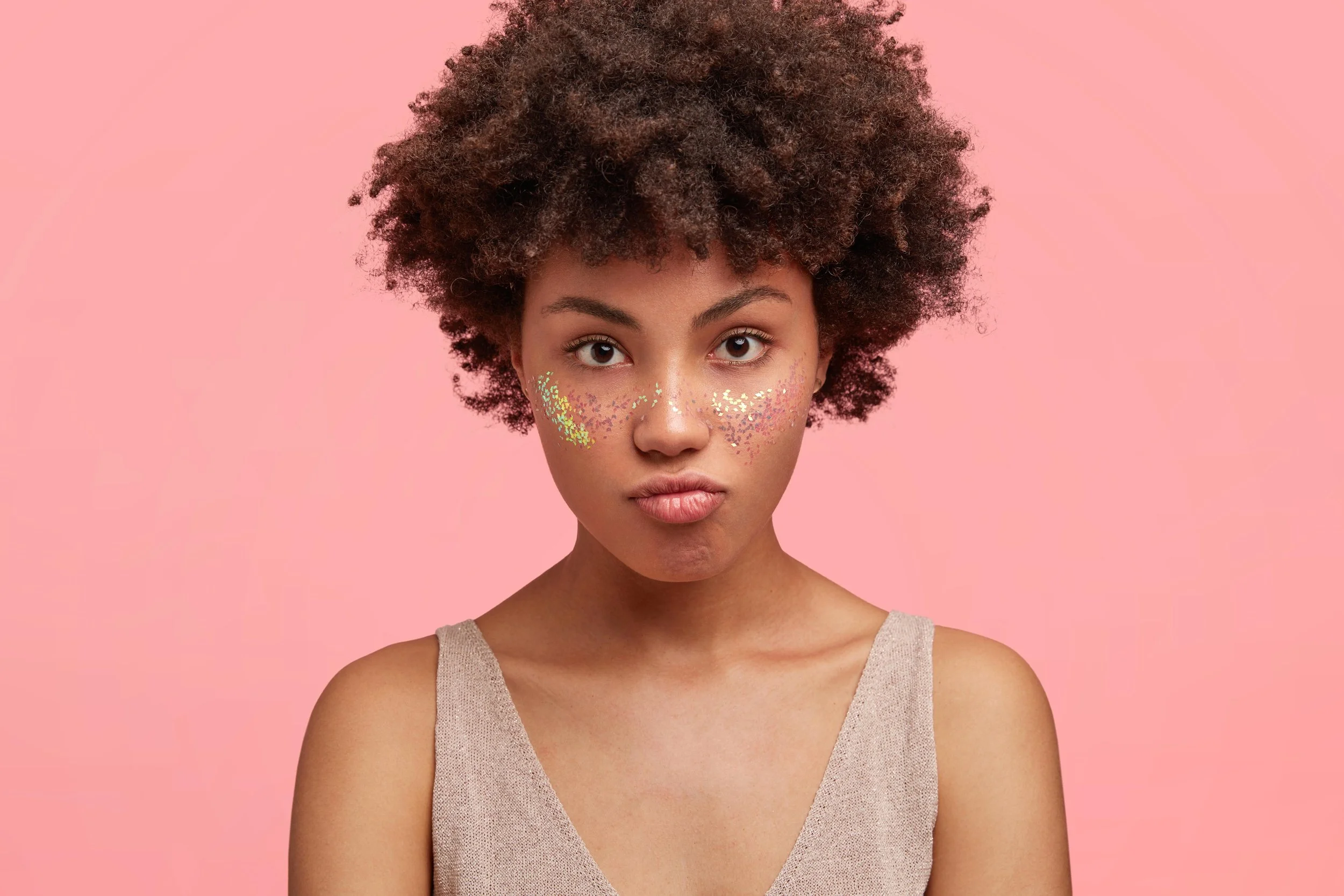🧪 How Long It Really Takes to Fade Dark Spots (With Evidence + Timelines)
This post contains affiliate links. As an Amazon Associate, I earn from qualifying purchases—at no extra cost to you. I only recommend products I truly believe in.
Let’s Talk Spots
Got a dark spot that’s been clinging to your cheek like an ex who doesn’t get the hint? They show up uninvited and take forever to leave—but this time, you’ve got science on your side.
Whether it’s a leftover from a breakout (ahem, post-inflammatory hyperpigmentation), a sun-induced souvenir from your SPF-free past, or melasma being its stubborn self, dark spots can seriously overstay their welcome. And no, scrubbing harder or layering three serums at once isn’t the solution—it’s more likely to wreck your skin barrier than fade a single spot.
Here’s what you actually need:
A breakdown of what kind of dark spot you’re dealing with,
How long it typically takes to fade (naturally and with treatment),
Science-backed ingredients that are proven to work,
And dermatologist-loved products that give results without triggering more irritation.
So if you’ve ever wondered “How long does it take to fade hyperpigmentation?”—or stared at that one mark for six months wondering if it’s permanent—you’re in the right place.
Let’s fade those spots the smart, sciencey way. ☕✨
🔬Understanding Hyperpigmentation (a.k.a. Why That Spot Is Still There)
Before you can kick a dark spot to the curb, you’ve got to know what you’re dealing with. Not all hyperpigmentation is created equal—and yes, some types are more dramatic and clingy than your high school ex. Let’s break down the main troublemakers:
🩹 Post-Inflammatory Hyperpigmentation (PIH)
This is what happens when your skin throws a tantrum (acne, bug bite, eczema flare), and instead of apologizing, it leaves a little reminder behind.
What it looks like: Flat, brown, purplish, or grayish marks that hang around after inflammation.
What causes it: Your skin gets inflamed, melanin overreacts, and boom—spot city.
How long it lasts: Weeks to months if you’re lucky, up to a year if it’s feeling spiteful (and if you don’t treat it right).
🌞 Sunspots (aka Solar Lentigines)
These are the receipts from your sunscreen-skipping years.
What they look like: Flat, brown dots that pop up on your face, chest, and hands like “surprise!”
Why they exist: Chronic sun exposure damages skin and sends melanin into overdrive.
Longevity: These spots are like permanent roommates unless you break out serious treatments (think retinoids, acids, or lasers).
🤰 Melasma
Melasma is that one friend who shows up uninvited and refuses to leave—even when you’ve clearly set boundaries.
The vibe: Patchy brown or gray-brown spots, often symmetrical, across the cheeks, forehead, and upper lip.
What sparks it: Hormonal changes (hello, pregnancy and birth control), stress, and—you guessed it—UV rays.
Fun fact: It’s chronic. You can fade it, but it likes to boomerang back unless you’re an SPF ninja.
👀 How Deep Is Your Spot? (And Why It Matters)
Here’s where it gets nerdy (and important): not all dark spots sit at the same level in your skin.
Epidermal pigmentation = surface level = quicker fade.
Dermal pigmentation = deeper = stubborn AF.
💡 Quick hack: If your spot looks brown, it’s probably epidermal (yay!). If it looks bluish or gray, it’s dermal—and you’ll need more time, more actives, and probably more snacks to get through it.
⏳ Timelines – How Long Does It Really Take?
Let’s rip the Band-Aid off: dark spots don’t vanish overnight. If a serum promises results in three days, it’s either lying or just very confident in your lighting. The truth? How fast your hyperpigmentation fades depends on three things: what caused it, how deep it is, and how you treat it.
So how long does it take to fade dark spots? Let’s break it down:
🐢 No Treatment = A Whole Lotta Waiting
If you’re doing nothing but hoping and manifesting clear skin, here’s what you’re looking at:
- Post-inflammatory hyperpigmentation (PIH): 3 to 24 months to fade on its own. Yep, months. And the deeper the inflammation went (like with cystic acne), the longer it hangs around.
- Sunspots: Basically permanent unless you intervene. These guys are seasoned squatters.
- Melasma: Chronic and recurring. It may fade slightly over time, but usually sticks around unless treated—and even then, it needs ongoing maintenance.
So yeah. Your skin can do some healing solo, but it’s the long route. Like, “drive across the country without snacks” long.
🚀 With Treatment = Let’s Actually Get Somewhere
Science to the rescue! Here’s what the research says when you use the right actives consistently:
| Treatment | Time to See Results | Best For | Backed By |
|---|---|---|---|
| Vitamin C (10–20%) | Brightening in 4–8 weeks | Mild PIH, dullness, early sunspots | Ngoc et al., 2023 |
| Retinoids (adapalene, tretinoin) | 8–12 weeks | PIH from acne, epidermal melasma | Zouboulis et al., 2019 |
| Azelaic Acid (15–20%) | 8–16 weeks | PIH and melasma (safe for sensitive skin) | Boo, 2021 |
| Hydroquinone (2–4%) | 4–12 weeks | Melasma, stubborn sunspots | Tsai & Chien, 2022 |
| Tranexamic Acid | 8–12 weeks | Hormonal melasma, resistant pigmentation | Ngoc et al., 2023 |
| Cysteamine | Around 16 weeks | Deep melasma, long-standing sunspots | Sahawneh, 2024 |
| Laser treatments | 4–6 weeks (50% fade typical) | Sunspots, dermal melasma, severe PIH | Seck et al., 2023 |
🧴 Reminder: These timelines assume daily sunscreen and no sabotage (like using acids five nights a week while skipping moisturizer). Be gentle, consistent, and patient.
⌛ Real Talk: Why Some Spots Take Forever
Let’s say you’re doing everything right—why hasn’t your spot faded?
- It might be dermal, not epidermal (deeper = slower results).
- You could be unintentionally re-triggering pigmentation with sun exposure or harsh actives.
- You might be mixing too many products that cancel each other out or irritate your skin.
- Or… you might just need more time. We know, the worst answer.
💡 Pro tip: Take monthly progress pics in the same lighting. Trust the process. And remember: “no change” for two weeks doesn’t mean it’s not working—science takes time, baby.
💡 Science-Backed Ingredients That Work (and the Ones That Just Want Your Money)
Now that we’ve accepted the tragic truth that dark spots take forever to fade without help, it’s time to talk ingredients that actually do something. Not trendy oils. Not “miracle” serums from influencers who think glycolic acid is a vibe. We’re talking clinically studied, dermatologist-approved, peer-reviewed legends.
Here’s your hyperpigmentation all-star lineup:
🧪 Hydroquinone
The heavy-hitter. The OG. The Beyoncé of dark spot fading.
- It blocks melanin production at the enzyme level (specifically tyrosinase—science flex ✅).
- Most effective when used in short-term bursts under derm supervision.
- Often combined with retinoids and steroids in prescription blends (like Tri-Luma) for max power.
Best for: Melasma, sunspots, and stubborn PIH
Not great for: Long-term use or sensitive skin (can cause irritation and rebound pigment with overuse)
🌀 Retinoids (Retinol, Tretinoin, Adapalene)
A multitasker with a glow-up agenda.
- Speeds up cell turnover so dark, pigmented cells get replaced faster.
- Also boosts collagen, so you’re fading spots and aging backwards. Iconic.
- Available OTC (retinol, adapalene) or Rx (tretinoin).
Best for: PIH, photoaging, early-stage melasma
Watch for: Irritation—start slow and use SPF like your skin depends on it (because it does)
🧊 Azelaic Acid
Underrated, but secretly amazing—like the friend who always has sunscreen in their bag.
- Naturally derived from grains and safe for all skin tones and types.
- Reduces melanin production and inflammation—so it fades spots and calms redness.
- Can be used during pregnancy and plays nice with others.
Best for: PIH, rosacea, melasma, sensitive skin
Clinical dose: 15–20% (prescription), but OTC 10% can still help with consistency
🔥 Tranexamic Acid
Melasma’s worst enemy.
- Works by blocking UV- and hormone-triggered melanin pathways (nerd alert 🧠).
- Can be used topically or prescribed orally for stubborn cases.
- Often combined with other ingredients like niacinamide or kojic acid for boosted results.
Best for: Hormonal melasma, discoloration from hormonal birth control
Results: Around 8–12 weeks with consistent use
🌱 Cysteamine
The new kid on the block with serious receipts.
- Works by inhibiting multiple pigment production pathways (like hydroquinone—but gentler).
- Slight sulfur smell, but worth it for the glow-up.
- Requires specific instructions: short contact time followed by wash-off.
Best for: Deep melasma, resistant sunspots
Timeframe: Visible improvements in 12–16 weeks
🍇 Arbutin (and Alpha-Arbutin)
Nature’s take on pigment control—with fewer side effects.
- Derived from bearberry plants and inhibits tyrosinase, like hydroquinone—just without the drama.
- Great for layering with other ingredients (especially niacinamide and licorice root).
Best for: Mild-to-moderate hyperpigmentation, sensitive skin
Caution: Results take time, but it’s a solid long-term player
✨ Vitamin C (Ascorbic Acid)
Brightens, defends, and boosts other ingredients—like the ultimate wingwoman.
- Antioxidant that fights free radicals and blocks pigment production.
- Best when formulated at 10–20% with proper pH (between 3.5–4 for stability).
- Pair with vitamin E and ferulic acid for even better results.
Best for: Dullness, early sunspots, uneven tone
Bonus: Plays well under SPF and boosts its protection
💡 Pro tip: These ingredients aren’t “pick one and pray.” Most work even better when layered properly (and gently). In Section 4, we’ll get into actual product recs that combine these ingredients like a dream.
🧴 Product Recommendations (That Actually Work—And Aren’t Just Pretty Bottles)
You’ve met the star ingredients—now let’s talk products that bring the science and the results. Whether you’re on a drugstore budget or ready to swipe for luxury, these recs feature the right actives (in the right concentrations) to help fade dark spots faster—and smarter.
🧪 Hydroquinone
Ambi Fade Cream (2% hydroquinone) – One of the few OTC options still available. Works best for mild PIH and sunspots.
👉 Check price on Amazon
Tri-Luma Cream – Prescription-strength triple combo: hydroquinone, tretinoin, and fluocinolone. Best for melasma and stubborn pigmentation. Derm-supervised only.
🌀 Retinoids
Differin Gel (Adapalene 0.1%) – An FDA-approved retinoid for acne that also fades PIH with consistent use.
👉 Check price on Amazon
Paula’s Choice 1% Retinol Treatment – Potent and well-buffered, great for those already comfortable with retinoids.
👉 Check price on Amazon
Tretinoin (Retin-A) – Prescription-only retinoid that increases cell turnover and reduces deep pigmentation over time. Comes in multiple strengths (0.025%–0.1%). Ask your derm if OTC isn’t cutting it.
🧊 Azelaic Acid
The Ordinary Azelaic Acid Suspension 10% – A budget-friendly staple that targets pigmentation and calms inflammation.
👉 Check price on Amazon
Finacea Gel (15%) – Prescription azelaic acid that’s gentler, more powerful, and perfect for redness-prone skin. Especially helpful for melasma or rosacea-related pigmentation.
🔥 Tranexamic Acid
The Inkey List Tranexamic Acid Night Treatment – Lightweight formula ideal for layering. Great for melasma and stubborn pigmentation.
👉 Check price on Amazon
🌱 Cysteamine
Cyspera (Cysteamine Cream) – A derm-dispensed pigment corrector that’s shown great results for deep melasma and resistant hyperpigmentation. Not sold on Amazon, but worth a derm consult.
Urban Skin Rx HyperCorrect Intense Fading Cream – A cysteamine-based alternative with strong reviews and better availability.
👉 Check price on Amazon
🍇 Arbutin
The Ordinary Alpha Arbutin 2% + HA – Simple, effective, and perfect for beginners.
👉 Check price on Amazon
Naturium Alpha Arbutin Serum 2% + Niacinamide – A great multitasking option for tone, texture, and brightening.
👉 Check price on Amazon
✨ Vitamin C
La Roche-Posay Pure Vitamin C Face Serum – Well-formulated and beginner-friendly, especially for sensitive skin types.
👉 Check price on Amazon
☀️ Sunscreen: Your Ride-Or-Die for Fading Dark Spots
Treating hyperpigmentation without SPF is like trying to put out a fire while someone keeps throwing matches. UV exposure is the #1 reason dark spots linger or come back—so consider this your non-negotiable.
EltaMD UV Clear Broad-Spectrum SPF 46 – Lightweight, calming, and formulated with niacinamide. Great for acne-prone and melasma-prone skin.
👉 Check price on Amazon
Black Girl Sunscreen SPF 30 – Hydrating, zero white cast, and packed with skin-loving ingredients. Ideal for deeper skin tones.
👉 Check price on Amazon
La Roche-Posay Anthelios Melt-In Milk SPF 60 – Broad-spectrum protection with a silky finish. Works well under makeup.
👉 Check price on Amazon
Supergoop! Unseen Sunscreen SPF 40 – Invisible, silicone-like texture that doubles as a makeup primer.
👉 Check price on Amazon
Hero Force Shield Superlight SPF 30 – Zinc-based with a green tint that neutralizes redness. Great for post-acne hyperpigmentation.
👉 Check price on Amazon
💬Real Talk – Managing Expectations
Here’s the part where we lovingly burst your bubble: even with gold-standard ingredients and your most disciplined skincare era… dark spots do not fade overnight. This is a slow-burn relationship, not a summer fling.
🕒 First off: timelines are longer than you think
Most ingredients take at least 8–12 weeks to show real progress. Not because they’re weak, but because your skin has to turn over, rebuild, and slowly let go of that excess melanin. Deep spots (like dermal melasma or post-acne marks from cystic breakouts) can take 3–6 months or more to significantly fade.
📅 You need consistency—not constant switching
Don’t ghost your routine just because you didn’t wake up with glass skin after a week. Skincare works when you give it time. If you’re bouncing between new products every two weeks, you’re not treating your skin—you’re confusing it.
☀️ SPF is non-negotiable
We’ve said it before (and we’ll keep saying it): treating dark spots without sunscreen is like whitening your teeth while drinking red wine. One step forward, two pigment-boosted steps back. No matter what actives you use, daily SPF is what locks in your progress.
📸 Progress is real—even if you don’t see it yet
Your mirror is a liar. Take photos once a month in the same lighting. You’ll be shocked at what you notice over time—fewer shadows, softer edges, a more even glow. But don’t expect overnight miracles.
💡 Some spots might fade. Some might just improve. And that’s okay.
Skincare isn’t about perfection—it’s about progress. If a stubborn spot softens, blends in, or stops feeling like the first thing you see in the mirror, that’s a win.
🧠 Your Glow-Up Isn’t Canceled — It’s Just on a Schedule
If you’ve made it this far, congrats — you now officially know more about fading dark spots than half the skincare TikTok influencers combined. 🧪✨
To recap:
- Not all dark spots are created equal — PIH, melasma, and sunspots all have different causes, depths, and timelines.
- Ingredients matter, and the ones backed by science (like retinoids, azelaic acid, vitamin C, and tranexamic acid) take time but work.
- Consistency is everything, and SPF is your MVP — don’t bother with fancy serums if you’re not protecting your progress every day.
- Some spots will fade. Some will linger. But with a good routine, your skin will look more even, brighter, and more you.
Let’s be real—you want clearer skin. And guess what? It’s possible. Not overnight, but with the right ingredients and consistency, you’ll get there.
Here’s to skin that feels like yours — just glowier. 💫
Want to dig deeper?
If you want a gentle, evidence-backed active to start with, TXA is a smart pick that plays well with most routines.
You’ll maintain gains faster when you choose proven ingredients, so build your plan around these five workhorses.
None of this sticks without daily SPF, and the data shows sunscreen can even help spots fade.
📚 References
- Abhishek S, Anjali T, Lekshmi S. Ecoskinomics: Exploring the ecological factors shaping skin health. IEEE Xplore. 2023. Link
- Boo YC. Mechanistic basis and clinical evidence for nicotinamide in controlling skin aging and pigmentation. Antioxidants. 2021;10(8):1315.
- Boo YC. Ascorbic acid for dermal collagen and antiaging. Antioxidants. 2022;11(9):1663.
- Lee JD, Oh MJM. Medical skin care. In: Lasers in Dermatology. Springer; 2023. p. 35–46.
- Ngoc LTN, Moon JY, Lee YC. Antioxidants for improved skin appearance. Int J Cosmetic Sci. 2023;45(3):299–314.
- Qassem M, Kyriacou PA. Modern techniques for skin hydration assessment. Cosmetics. 2019;6(1):19.
- Sahawneh P. Factors influencing skin health from within. J Integrated Health. 2024;30(1):156–163.
- Seck S, Hamad J, Schalka S, Lim HW. Photoprotection in skin of color. Photochem Photobiol Sci. 2023;22(2):441–456.
- Tsai J, Chien AL. Photoprotection for skin of color. Am J Clin Dermatol. 2022;23(2):195–205.
- Zouboulis CC, et al. Skin aging, prevention, and local treatment. Clin Dermatol. 2019;37(4):365–372.


